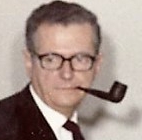Bence Adorján
He worked at Hungária Vegyiművek between 1942 and 1948. Initially, he dealt with investment planning and the efficiency analysis of industrial investments.
Between 1948 and 1950, he was the chief lecturer at the National Planning Office (OT), and then between 1950 and 1957, he was its head of department. He participated in the preparation of economic studies directed by the State Economic Department and in the development of the first national economic plans. In 1953, he obtained a higher qualification in national economic planning; in 1959, he obtained a degree in electrical engineering.
Between 1957 and 1966, he was a scientific associate and deputy head of the Electronics Department of the Central Physical Research Institute (KFKI) of the Hungarian Academy of Sciences, and then head of the department between 1968 and 1969. He played a significant role in the Hungarian success of the 1958 Brussels World's Fair as head of the scientific exhibition and presentation department of the Hungarian pavilion.
From 1960 to 1967, he was head of the nuclear instrumentation section of the Committee on the Peaceful Uses of Atomic Energy of the Council for Mutual Economic Assistance (CMEA).
Between 1968 and 1969, he was the plant manager of the Electronic Development and Experimental Instrument Manufacturing Company.
From 1969 to 1972: scientific and technical-economic advisor of the Computer Science Coordination Institute (SZKI), then deputy director between 1972 and 1981, and retired scientific advisor until 1989.
In 1976, he obtained the title of Candidate of Economic Sciences (the first Hungarian candidate in computer science); then in 1985, he received the title of Doctor of the Hungarian Academy of Sciences.
1976-1980: Head of the Futures Research Committee of the Hungarian Academy of Sciences.
His computer science works published in the 1980s were classic papers that generated a great deal of press coverage - his findings analyzing society's growing computer addiction are particularly valuable. His popularization articles often appeared in various dailies, weeklies, and magazines.
Awards: Bronze (1969) and Silver (1979) degrees of the Order of Merit for Labor.
Created: 2016.01.13. 18:56
Last modified: 2025.02.17. 18:34

